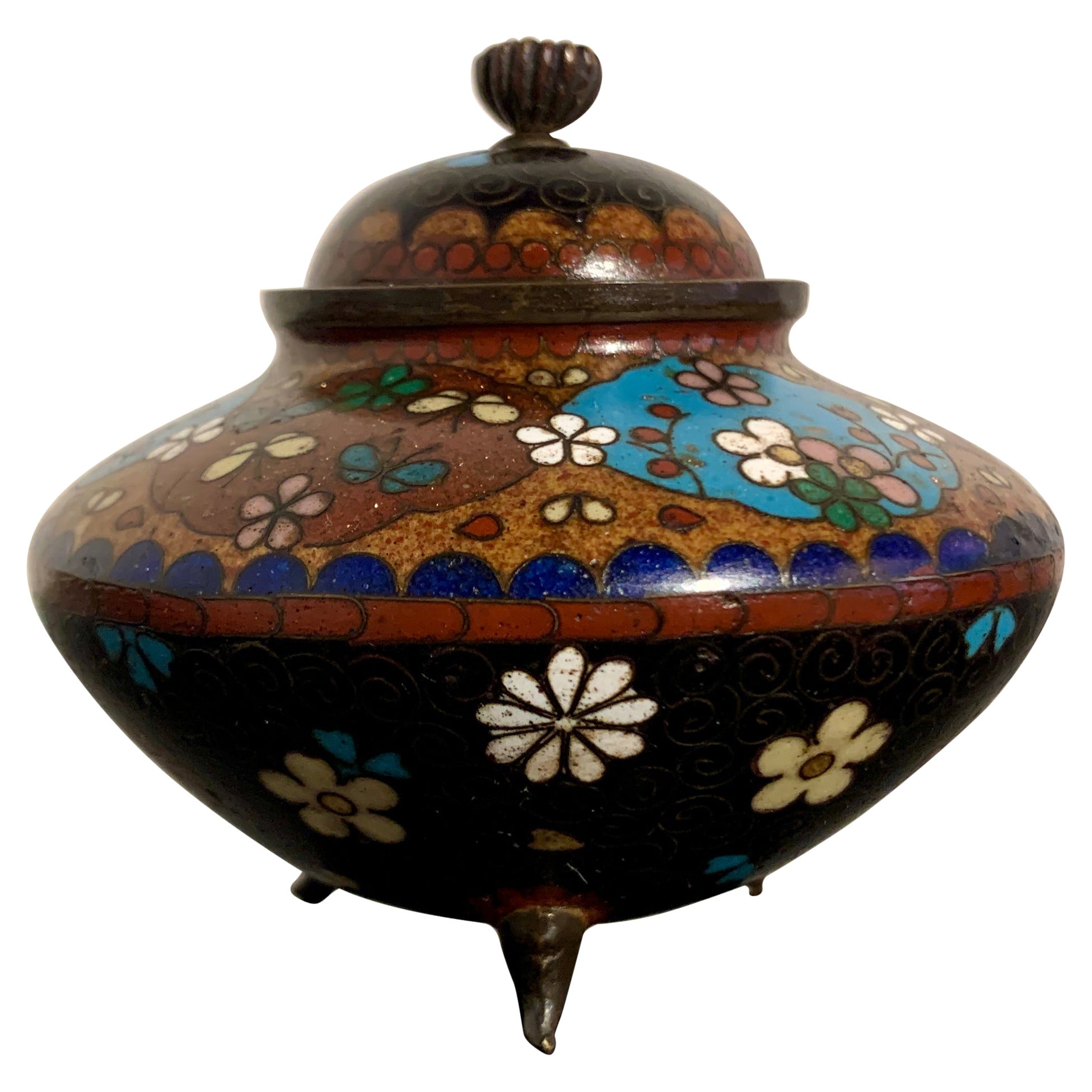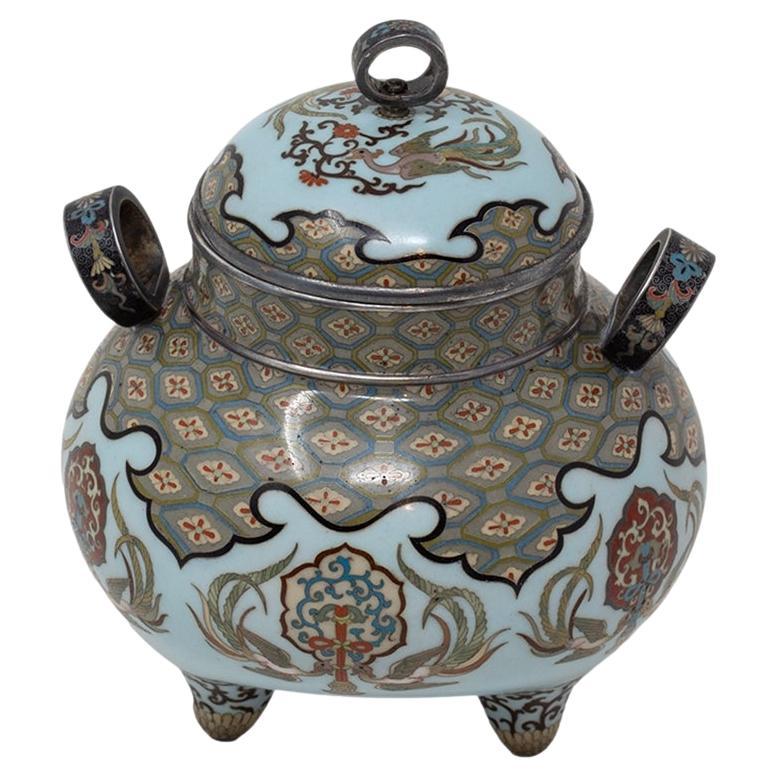Items Similar to Japan 1890 Meiji Period Bronze Koro Censer in Cloisonne Enamel with Jade Lid
Want more images or videos?
Request additional images or videos from the seller
1 of 7
Japan 1890 Meiji Period Bronze Koro Censer in Cloisonne Enamel with Jade Lid
About the Item
Japanese Koro from the Meiji Period (1868-1912).
Beautiful antique ten sides fluted koro censer, created in Japan during the Meiji period (1868-1912), circa 1890's. It was carefully crafted in solid bronze with copper wires and embellished with applications of polychromatic cloisonne enamel with silver and gold flakes, depicting organics and natural motifs such butterflies and flowers.
The lid on top is embellished with a sphere of 13 mm carved from natural green nephrite jade.
Has a total weight of 360.7 Grams and a measurements of 134 mm by 127 mm (5.25 x 5 Inches).
Meiji period, is an era of Japanese history that extended from October 23, 1868 to July 30, 1912.The Meiji era was the first half of the Empire of Japan, when the Japanese people moved from being an isolated feudal society at risk of colonization by Western powers to the new paradigm of a modern, industrialized nation state and emergent great power, influenced by Western scientific, technological, philosophical, political, legal, and aesthetic ideas. As a result of such wholesale adoption of radically different ideas, the changes to Japan were profound, and affected its social structure, internal politics, economy, military, and foreign relations. The period corresponded to the reign of Emperor Meiji. It was preceded by the Keio era and was succeeded by the Taisho era, upon the accession of Emperor Taisho.
Koro, is a Japanese censer, incense burner, perfume burner or pastille burner is a vessel made for burning incense or perfume in some solid form. They vary greatly in size, form, and material of construction, and have been in use since ancient times throughout the world. They may consist of simple earthenware bowls or fire pots to intricately carved silver or gold vessels, small tabletop objects a few centimeters tall to as many as several meters high. Many designs use openwork to allow a flow of air. In many cultures, burning incense has spiritual and religious connotations, and this influences the design and decoration of the censer.
Cloisonné is an enamelling technique in which the pattern is formed by wires soldered to the surface of the object to be decorated, which is usually made from copper, forming cells or cloisons, each of which holds a single colour of enamel paste which is then fired, and ground and polished. The champleve technique also uses an enamelling technique, but the cells are formed by carving into the surface ot the object, or in the casting. The cloisonne technique has been in use since the 12th century BC in the west, but the technique did not reach China until the 13th or 14th century. It became popular in China in the 18th century. Initially bronze or brass bodies were used, and in the 19th century copper, at which time the quality of th eitems produced began to decline. Chinese cloisonné is the best known enamel cloisonné, though the Japanese produced large quantities from the mid-19th century, of very high technical quality. In the west the cloisonne technique was revived in the mid 19th century following imports from China, and its use continued in the Art Nouveau and Art Deco periods.
Butterflies, Japan perceives the butterfly to be a 'soul of the living and the dead', as a result of the popular belief that spirits of the dead take the form of a butterfly when on their journey to the other world and eternal life. In Japanese culture, butterflies carry a number of meanings but are most closely associated with the symbolism of metamorphosis and transformation. Its curvaceous shape is commonly met with affection as a symbol of good luck, good health and prosperity.
It is in great condition, with the normal traces of use.
INVENTORY REF: D0000MNNK/.1112.
- Dimensions:Height: 5.25 in (13.34 cm)Width: 5 in (12.7 cm)Depth: 5 in (12.7 cm)
- Sold As:Set of 2
- Style:Meiji (Of the Period)
- Materials and Techniques:
- Place of Origin:
- Period:
- Date of Manufacture:1890
- Condition:Wear consistent with age and use. It is in great condition, with the normal traces of use.
- Seller Location:Miami, FL
- Reference Number:
About the Seller
5.0
Platinum Seller
These expertly vetted sellers are 1stDibs' most experienced sellers and are rated highest by our customers.
1stDibs seller since 2023
63 sales on 1stDibs
Typical response time: <1 hour
- ShippingRetrieving quote...Ships From: Miami, FL
- Return PolicyA return for this item may be initiated within 1 day of delivery.
More From This SellerView All
- Japan 1890 Meiji Period Decorative Vase In Cloisonné Enamel With Wood BaseLocated in Miami, FLJapanese vase from the Meiji Period (1868-1912). Beautiful antique decorative vase, created in Japan during the Meiji period (1868-1912), circa 1890s. It was carefully crafted in so...Category
Antique 1890s Japanese Meiji Metalwork
MaterialsBronze, Enamel
- Ota Jinnoei 1890 Imperial Meiji Period Pair of Cloisonne Cabinet VasesBy Ota JinnoeiLocated in Miami, FLPair of cloisonne vases designed by Ota Jinnoei. Beautiful pair of small cabinet vases, created in Japan circa 1890, during the meiji Imperial period (1868-1912). These vases has ...Category
Antique 1890s Japanese Meiji Metalwork
MaterialsSilver, Bronze, Enamel
- Japan 1900 Meiji Period Charger With A Dragon In Cloisonné Multicolor EnamelLocated in Miami, FLLarge charger in cloisonné from imperial Japan. Beautiful piece of Japanese decorative arts, created during the Meiji imperial period, circa ...Category
Antique Early 1900s Japanese Meiji Metalwork
MaterialsBronze, Copper, Enamel
- Japan Meiji 1900 Three Bronze Ducks Sculpture in Wood Stand and CoralLocated in Miami, FLSculptural composition of the ducks from the Japanese Meiji Period. Beautiful and very well realized sculptural composition of three ducks, made during the japanese imperial perio...Category
Antique Early 1900s Japanese Meiji Sculptures and Carvings
MaterialsCoral, Bronze
- Ando Jubei Japan 1950 Showa Period Cloisonné Enamel Green Bombe VaseBy Ando JubeiLocated in Miami, FLCloisonné enamel vase designed by Ando Jubei. Beautiful piece of Japanese decorative arts, created by the Ando Jubei Company during the Showa...Category
Vintage 1950s Japanese Showa Vases
MaterialsSilver, Enamel
- Japan 1890 Meiji Period Signed Assembling of Okimono with a Group of SkeletonsLocated in Miami, FLA signed Okimono from the Japanese Meiji period (1868-1912). Very rare, unusual and large sculptural assembling of a dysplaying piece of okimono. Created in Japan during the imperial period of the Meiji (1868-1912). This extraordinary piece okimono sculpture depict a group of four intricately and realistically rendered carousing males skeletons representations (Gaikotsu) standing in several position. One skeleton is crouched down playing with mouses in the floor. The second is seated resting in the other's back, peacefully smoking opium. The others two are fully standing in interacting position. The entire composition is arranged freely displayed on the wood base including a woven basket, apparently with food and four playfull mouses. There are an extra five mouses in different positions, freely playing around, all of them with the eyes accented with carved black ebony. The composition is displayed on a four-legged free form carved wood platform with an inlaid red plaque engraved with the artist's signature. The level of detail and the quality of the carving is truly exceptional. Has an exact measurements of 216.15 mm by 139.7 mm by 359.41 mm (8.51 x 5.5 x 14.15 Inches). After an extensive collection of data, comparables and references to this piece, we have only been able to find only three okimono sculptures like this, with similar themes and the same quality of work. References Note: A similar carving of four skeletons playing an animated game of dominos, signed Shutaro in an inlaid rectangular red plaque, was sold in London by Christie’s South Kensington in October 14 2014, Lot 120 Sale 5546. References Note: A similar carving with four skeletons in an otherwise typical victorian scene of a photographer and three sitters signed Shutaro in an inlaid rectangular red plaque, was sold in Edinburgh at Lyon & Turnbull in November 7, 2018. References Note: A similar carving with five skeletons seated, playing cards and drinking, was sold in London by John Nicholson Fine Art on September 26, 2018. Meiji period, is an era of Japanese history that extended from October 23, 1868 to July 30, 1912.The Meiji era was the first half of the Empire of Japan, when the Japanese people moved from being an isolated feudal society at risk of colonization by Western powers to the new paradigm of a modern, industrialized nation state and emergent great power, influenced by Western scientific, technological, philosophical, political, legal, and aesthetic ideas. As a result of such wholesale adoption of radically different ideas, the changes to Japan were profound, and affected its social structure, internal politics, economy, military, and foreign relations. The period corresponded to the reign of Emperor Meiji. It was preceded by the Keio era and was succeeded by the Taisho era, upon the accession of Emperor Taisho. Okimono, is a Japanese term meaning for display an ornament; art object; or decorative object, usually displayed in a tokonoma or butsudan "Buddhist altar". It is an ornament or figure, especially one placed in a guest room. An okimono may be a small Japanese carving...Category
Antique 1890s Japanese Meiji Sculptures and Carvings
MaterialsWood
You May Also Like
- Japanese Cloisonne Enamel Vase Pair Meiji PeriodLocated in Newark, EnglandA sensational pair of Japanese Meiji period Cloisonne enamel bottle vases. The vases of slender hexagonal form with trumpet opening upon a circular foot. Decorated to the highest qua...Category
Antique Late 19th Century Japanese Meiji Metalwork
MaterialsMetal, Silver
- Small Japanese Cloisonné Censer, Koro, Meiji Period, Late 19th Century, JapanLocated in Austin, TXA small and delightful Japanese cloisonné and goldstone tripod incense burner and cover, Meiji period, late 19th century, Japan. The small incense burner...Category
Antique Late 19th Century Japanese Meiji Metalwork
MaterialsCopper, Enamel
- Large Meiji Period Cloisonne Enamel KoroLocated in London, GBLarge Meiji Period Cloisonne Enamel Koro Japanese, late 19th Century Height 88cm, width 76cm, depth 53cm This superb cloisonne enamel koro was made during Japan's Meiji period, and ...Category
Antique Late 19th Century Japanese Meiji Metalwork
MaterialsBronze, Enamel
- Japanese Meiji Period Cloisonne Enamel Koro signed Tsukamoto HikokichiLocated in Newark, EnglandThe Koro of exceptional quality shaped in bulbous squat form with three looped handles and removable lid raised on three tapered feet. The Koro with a sky blue ground decorated exten...Category
Early 20th Century Japanese Meiji Metalwork
MaterialsMetal, Enamel, Metallic Thread
- Large Japanese Bronze Koro Incense Burner, Meiji Period, 19th Century, JapanLocated in Austin, TXA large and fantastic Japanese cast bronze incense burner, koro, with high relief design, Meiji period, late 19th century, Japan. The large and tall koro cast in extremely high re...Category
Antique Late 19th Century Japanese Meiji Metalwork
MaterialsBronze
- Antique Japanese Meiji Bronze Censer Insence Koro Hand Warmer Brazier 1890Located in Portland, ORA good & large antique Meiji period Japanese bronze brazier, koro or handwarmer, circa 1890. The twin handled koro having a reticulated lid dec...Category
Antique 1890s Japanese Meiji Metalwork
MaterialsBronze
Recently Viewed
View AllMore Ways To Browse
Asian Influence Furniture
Modern 1890
1890 Japan
Japanese Influence Furniture
Japanese Art Deco
Art Deco Japan
Enamel Lid
Lidded Japanese
Mid Century Modern Enamel Art
Japanese Furniture Art Deco
Jade Asia
30s Antique Furniture
30S Antique Furniture
Japanese Emperor
Emperor Japan
Japanese Art Nouveau
Art Nouveau Japan
Antique Pot With Lid





